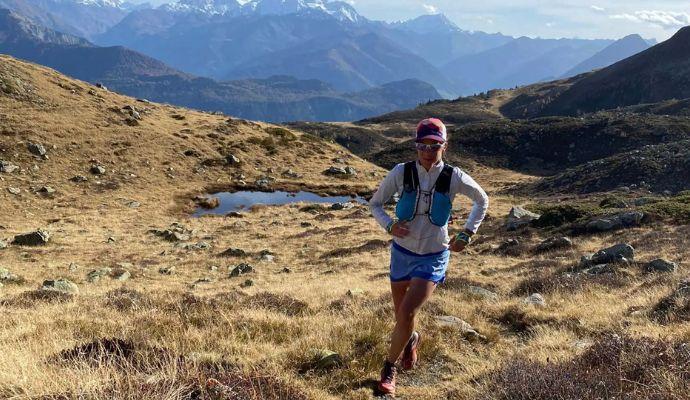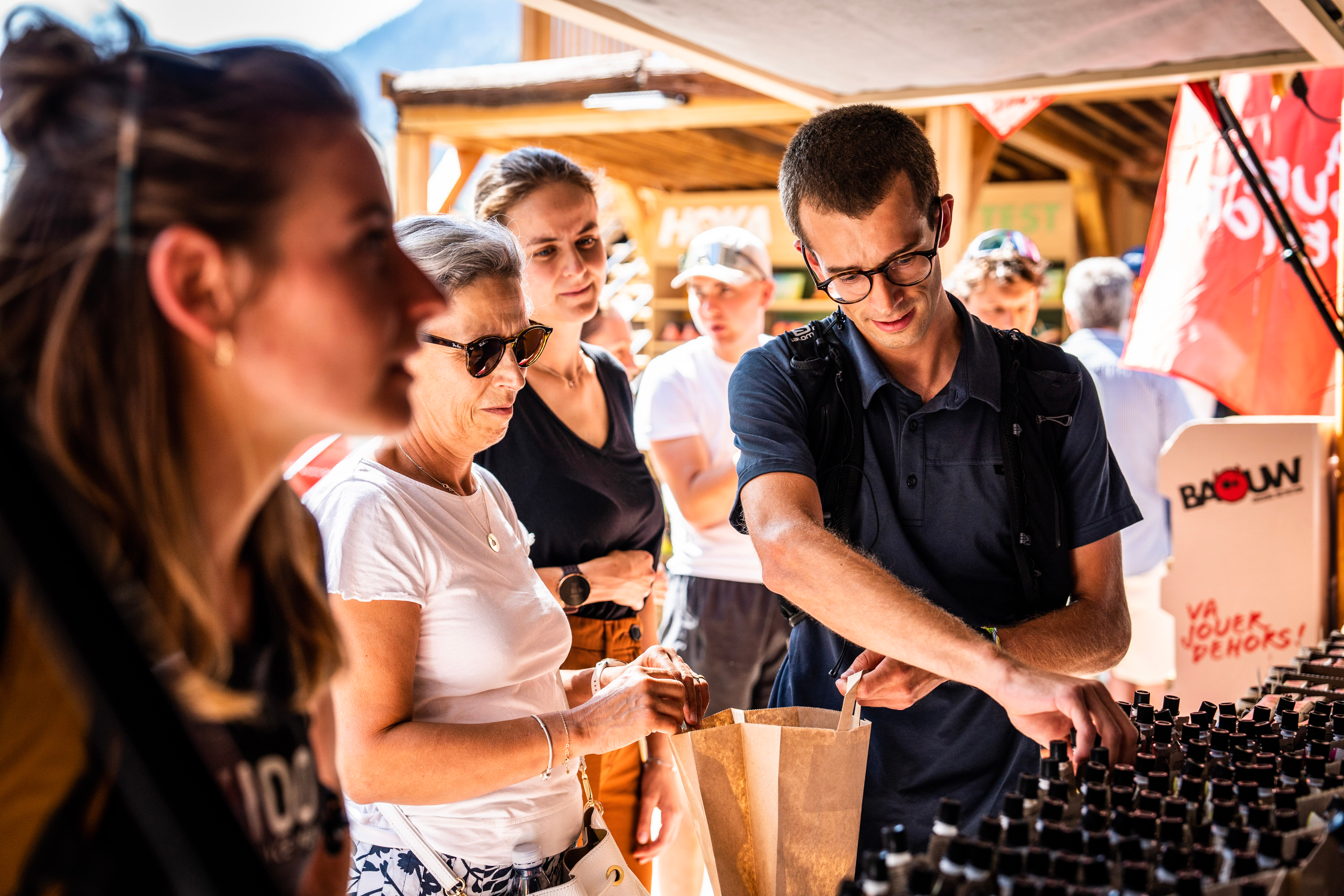Don't try to contact Emily Vaudan at the beginning of July: you'll get her answering machine! And why not? Because the chartered accountant, who in just a few years has become one of the world's top female ultra-trailers, will inevitably be running. And most certainly on her way to victory. Indeed, the Swiss woman from the Valais has made a speciality of performing in her favourite event, the Verbier Saint-Bernard trail, one of the most beautiful and demanding races on the UTMB circuit. Two-time winner of the X-Alpine, this 140km ultra-trail with a 9,300m vertical drop is the stuff of dreams and the stuff of fascination for even the most seasoned runners. Emily Vaudan has made this legendary event her backyard! A steep, wild garden that undulates through the heart of the Swiss Alps, on the side of glaciers, giving the impression of being in an idyllic postcard at the start, but brutal at the end. Yes, we promise you, the satisfaction and happiness of crossing the finish line will be equal to the difficulty and commitment required to complete it! The regional runner of the stage, newly Baouwer since 2022, gives us her preparation tips, her little secrets, her nutrition plan and the key points on the route to success in Switzerland's biggest ultra-trail. Episode 8 in the series ‘They shone there, they advise you’, can be enjoyed here and now (with the lilting accent that characterises the locals)!
EMILY VAUDAN'S ADVICE ON PREPARING FOR THE VERBIER SAINT-BERNARD BY UTMB TRAIL: ‘DURING THE RACE’.
TIP NO. 1: ‘BE AWARE THAT THIS IS ONE OF THE MOST DEMANDING TRAILS ON THE CIRCUIT’.
‘The Verbier Saint-Bernard Trail is one of the toughest in the world, whether in ultra-trail format, with the X-Alpine (140 km & 9300 D+), the X-Traversée (76 km & 5300 D+), the Marathon (42 km & 3000 D+) or the Verbier X-Plore (26 km & 1700 D+). Its reputation is well established. And that's what makes it such a great adventure. The satisfaction and happiness of crossing the finish line are equal to the difficulty and commitment required to complete it. That's why I don't recommend doing your first ultra-trail here, but rather seeing it as the goal that brings to fruition several months or even years of preparation.
TIP NO. 2: ‘TAME THE STEEP SLOPES #1: IN WINTER’.
‘The Trail de Verbier Saint-Bernard is very steep. The ratio of positive and negative gradients to the number of kilometres covered is one of the highest on the calendar. So, in winter, to prepare as well as possible for the steep slopes, I recommend maximising ski touring as much as possible. From December to March, I put my trainers away and do most of my training and racing as a ski mountaineer. I find this very beneficial for both body and mind. Firstly, it helps to develop the strength endurance that is essential for ultra-trail running. It also gives the body a rest: ski touring is very gentle, so the little aches and pains that often occur in the autumn, at the end of the trail season, disappear. I feel as good as new in the spring! Finally, this ‘cross-sport’ is good for my head: at the end of winter, I'm really motivated by the idea of running, after having been weaned off it for several months!
TIP 3: ‘TAME THE STEEP HILLS #2: EVEN MORE SO IN SPRING’.
‘Spring is all about the ability to transform the qualities developed over the winter into running qualities. That's what we call the ‘transfer’! To ensure that this happens effectively, I'm continuing to train on long, steep climbs, with lots of difference in altitude for few kilometres, to get used to the steep gradients that await me at the Trail de Verbier Saint-Bernard. I'm taking advantage of this spring's resumption of trail running to work up some intensity and blow my top! There's a good chance you'll come across me in the legendary Fully vertical kilometre at this time of year, as I like to do my ascent-descent sessions in the shuttle!'
TIP NO. 4: ‘DEVELOP YOUR UPPER BODY’.
‘On the Trail de Verbier Saint-Bernard, poles are absolutely essential! This is especially true on the ultra-long distances such as the X-Alpine or the X-Traversée. The climbs are very steep, so opportunities to run are rare. The climbs are more likely to be done in ‘power hike’ mode, in other words ‘stick-walking’ at a fairly steady pace. With this in mind, it's vital to develop your upper body, particularly your arms, to save your legs. The poles almost have to become a natural extension of the runner, and it has to be very intuitive to use them!
TIP 5: ‘TRAIN FOR LONG DESCENTS’.
‘I've noticed that trailers often work a lot on their climbing skills, while neglecting a little their ability to ‘go down well’, certainly because they consider it to be easier, more innate. Indeed, from a cardio and physiological point of view, descents are less interesting. But from a muscular point of view, it's fundamental! You have to get used to ‘breaking fibre’, especially for the Trail de Verbier Saint-Bernard where the descents are long, steep and technical. To prepare for this, I always try to do at least two climbs and two descents during each training session. This is so that I can learn to climb back up with the muscular fatigue caused by the first descent.
TIP NO. 6: ‘ACCLIMATISE TO ALTITUDE BY DOING A “RECO’.
‘I'm aware that acclimatising to altitude is like ski mountaineering: it's an easier tip for those who live in the mountains. For the more urban runners, I recommend one or two ‘shock weekends’, on alpine terrain, at altitude, to get to grips as much as possible with the sensation of running at an altitude of over 2000 m! The Orny hut, the summit of the race, rises to 2826 m! A good way to acclimatise and get a better idea of what awaits you on D-Day is to do a reconnaissance of the course over several days, in endurance, to build up the ‘volume’. For the X-Alpine course, the ultra format, I usually carry out this ‘recce’ in June, breaking it down as follows: a big first stage of 60 km on the first day, setting off from Verbier to sleep at the Hospice du Grand Saint-Bernard; then on the second day, heading for the Cabane Panossière, an absolutely fabulous place at the foot of the Grand Combin; and finally, returning to Verbier on the third day! On Monday, when you go back to work, I can assure you that you'll come back all calm!
TIP NO. 7: ‘CHOOSE YOUR PREPARATION RACE CAREFULLY’.
‘I find it very interesting to do a ‘preparation race’ before a big objective. The idea is to see it as a dress rehearsal that will allow you to build up your confidence and fine-tune the final details: your equipment, your nutrition, your hydration, your pace... In my opinion, a good preparation race is no longer than half the target race; it should take place between 8 and 4 weeks before D-Day; it should take place on similar terrain; and it should focus on the manner rather than the result. Equipment and nutrition can and should be tested in training, but in my opinion, there's nothing like live conditions and the adrenalin inherent in a race number to make the difference and avoid the unexpected on the day of the goal...’.
TIP NO. 8: ‘HAVE AN EXTREMELY METICULOUS NUTRITION AND HYDRATION PLAN’.
‘As well as trail running, I'm a chartered accountant, and it's perhaps this professional deformation that pushes me to be ultra-square when it comes to nutrition and hydration plans. As a result, before each race, I gain peace of mind by writing down a very precise plan of what I'm going to eat and drink, as well as my estimated times. The people who are going to provide my assistance benefit from a clear roadmap that makes everyone feel more at ease. Ideally, I'd also recommend keeping the same pairing as the race progresses, because a good race is a team effort that requires a certain degree of automatism. For my part, I'm lucky that one of my best friends is willing to come along and be my ‘feeder’!
TIP NO. 9: ‘FORCE YOURSELF TO EAT AT LEAST EVERY 45 MINUTES’.
‘I try to discipline myself by eating at least one barre énergétiqueor one compote énergétique every 45 minutes, even if I'm not hungry, to anticipate hypoglycaemia and ensure that my energy levels are as linear as possible, without any slumps. I also work on sensation: if I'm hungry, I shorten the 45-minute period to make sure I don't run out of anything. The same goes for hydration: I try to drink between 500 and 600 ml an hour!
TIP NO. 10: ‘BRING THE SWEET STUFF IN AS LATE AS POSSIBLE’.
‘With experience, I've realised that sweet things tend to turn me off quickly. So I prefer savoury recipes, whether they're barres énergétiques or compote PATATE DOUCE – CAROTTE – POIVRE DE TIMUT for as long as possible. For example, in the early hours of the morning, after 10 hours of running, I can't wait to get to the next feed station because I know there's a bun with dried meat waiting for me there! It invigorates me, and that's what keeps me running! I then switch to sweet recipes as and when I feel like it, in the second half of the race, favouring energy compotes (product link), which are easier to swallow when conditions get hotter and chewing is made more difficult by the effort.’
TIP 11: ‘MAKE YOUR OWN DRIED FRUIT MIXES’.
« Mon petit péché mignon, en course comme à l’entraînement, ce sont les mélanges de fruits secs. J’adore ça. Je trouve que cela booste vraiment l’énergie tout en restant très digeste, sans faire mal au ventre. J’en ai toujours un petit sachet avec moi, au cas où !
TIP N°12: ‘KNOW THE KEY POINTS OF THE COURSE!
‘I can think of 3. First of all, the passage to the Orny hut, the highest point of the Verbier Saint-Bernard Trail, at 2826 m, at the 46th km. It's a very long, steep climb that ends in scree, but rewards you with a breathtaking view, with daybreak at the summit. Then there's the descent from Panossière to Lourtier, at the 116th kilometre, which proves to be interminable with its 12 km distance, although the finish at the Col des Avouillons and its view of the Grand Comblin and the glacier is magnificent! Finally, there's the famous ‘final wall’, an almost vertical kilometre with 1200 m of ascent between Lourtier and Lachaux, to be climbed when you've already got 128 km and over 7000 m of ascent in your legs... Fortunately, after that, you're free! So, overall, my advice, in terms of race management, is to set off very carefully, taking into account that the race starts at La Fouly, at the 60th km!'
‘Consider that the race starts at La Fouly, at the 60th km!'
© Emily Vaudan








